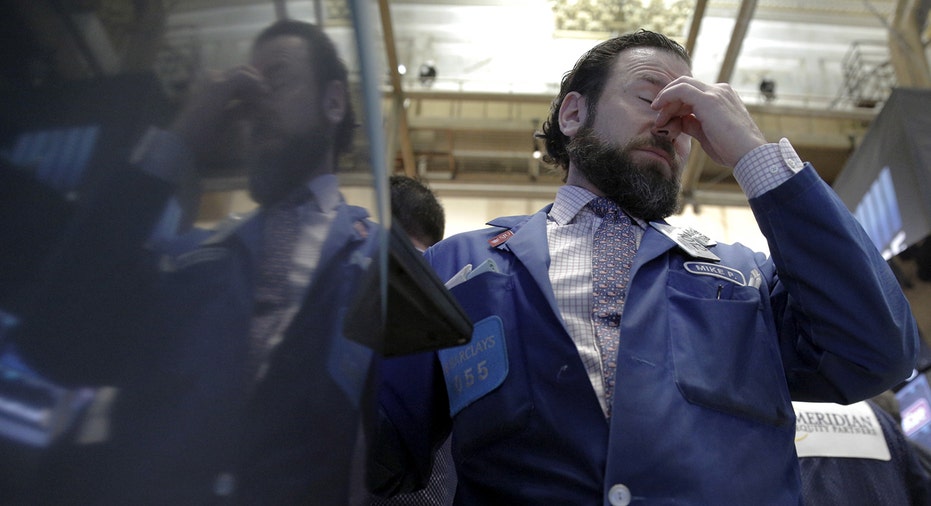Stocks Walloped by Selloff in Tech, Energy

U.S. equity markets came under increased selling pressure in the final hour of action Friday as a sharp selloff gripped Wall Street.
The sharp losses were led by the energy and technology sectors, and also extended to biotechnology. It led the Nasdaq to losses of 3.25%, or 146 points, to 4363. The S&P 500 shed 1.85%, or 35 points, to 1880, while the Dow declined 211 points, or 1.29% to 16204. Stocks ended off session lows.
So-called FANG stocks, Facebook (NASDAQ:FB), Amazon (NASDAQ:AMZN), Netflix (NASDAQ:NFLX), and Alphabet – Google’s parent company – (NASDAQ:GOOGL), fell particularly hard as they sold off with the rest of the tech sector thanks in large part to disappointing 2016 guidance, and weak fourth-quarter results, from professional networking site LinkedIn (NASDAQ:LNKD), which saw its steepest drop ever on Friday.
“Certainly there appears to be an exodus from the momentum that seemed to hold up performance in 2015,” Mark Heppenstall, chief investment officer at Penn Mutual Asset Management, which has $20 billion in assets under management, said. “It definitely feels like a reversal in risk appetite…some of the safer, more stable names are doing better. It’s a reversal in recent outperformers.”
Further, the energy sector, shed more than 3% into the close of trade as global oil prices extended declines after the 2:30 p.m. ET settle, as worries over how lower-for-longer prices will continue to impact parts of the world’s economy as consumers save more than they spend.
Dan North, chief economist at Euler Hermes North America, said part of the selloff’s momentum could also be due to January’s jobs report, which came in mixed. He said three factors tend to move markets: Earnings, interest rates, and emotion. And so far, all three of those looked like they were driving selling pressure on Wall Street.
“People are looking through the jobs report and a lot of guys are seeing that wage number, thinking it puts the rate hike back on the table for March, which I don’t believe, but…now you have higher rates, which works against stocks,” he explained.
The Labor Department showed the economy added 151,000 jobs during the month, far less than the 190,000 jobs analysts expected, and well below the 262,000 added in December, a downward revision from the 292,000 initially reported. The unemployment rate ticked down to 4.9%, the lowest level in eight years, from 5%, while the labor force participation rate rose to 62.7% from 62.6%.
Unexpectedly, factory jobs were a bright spot in the first month of the year, where 29,000 jobs were created, well above the expectation for a loss of 2,000 jobs. The December figures were revised up to 13,000 from 8,000.
Average hourly earnings, meanwhile, were up 2.5% from a year ago.
The read on U.S. employment came after a string of weak data on all parts of the economy. On Monday, the Institute for Supply Management reported the U.S. manufacturing sector notched its fourth-straight month of contraction as the gauge rose slightly to 48.2 in January from 48 in December. The reading was below the 50 mark that separates expansion from contraction. At the same time, the ISM manufacturing index’s employment component recorded its lowest reading since June. Factory data from the Commerce Department showed orders saw the biggest drop in a year.
Meanwhile, ISM’s gauge of service sector growth showed a slowdown in that area of the economy in January as well. The gauge dropped to 53.5 last month from 55.8 in December. It was the lowest reading since February 2014.
The U.S. economy, a bright spot so far in the global landscape, has shown signs of a possible slowdown ahead. But North said that’s not to say the economy is heading for a tailspin. His firm is still calling for growth of 2.3% for the year.
“We don’t expect a recession this year,” he said. “The stock market is great at giving off false signals because it trades on human emotion…we have job growth, income growth, consumption – none of it at an exciting pace – but it’s all positive.”
Mark Hamrick, Bankrate’s senior economic analyst, said the report was not quite at a Goldilocks level to him, but it wasn’t too hot or too cold, either.
“It wasn’t too hot to the extent that the Fed has to feel like it’s under pressure to raise rates in March, but not so cold to think we’re having a more substantial slowdown in the U.S. than what people might have thought,” he explained.
The Federal Reserve, when it raised rates for the first time in nearly a decade in December, said it saw the possibility of four more rate increases before the end of 2016. That forecast, according to Fed Fund futures, has dropped significantly, especially after remarks from key central bank officials who said they are closely monitoring developments in the global economy and the extent to which it impacts the U.S.
Hamrick said if the Fed is looking for a reason not to raise rates at its next meeting in March, there are plenty of other places to look, but the January jobs report alone isn’t enough to put hikes on hold.
“We have another jobs report before the next meeting…but I don’t think this changes the Fed’s view at the moment because it has been given reasons for caution about the next increase from elsewhere including dollar strength, tightening financial conditions, and sharp declines in commodities and crude prices.”
He continued by saying what the Fed really wants to know is whether the problem that Vice Chairman Stanley Fischer has described as “international” will cause a substantial concern in the U.S.
“When you look at this report…not so far,” Hamrick said. “But the other part is that if you’d told people two years ago the consumer would be given such a break on gas prices, you would have thought there would be an unprecedented strength in holiday shopping and there wasn’t anything close to that.”



















